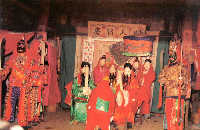 "Nuo," also called the "nuo sacrifice" or "nuo ceremony," was originally a type of sacrificial and magical ritual held to expel evil spirits and pestilence. Its name is derived from one of such rituals, where people shouted "nuo, nuo" to drive away the devil.
"Nuo," also called the "nuo sacrifice" or "nuo ceremony," was originally a type of sacrificial and magical ritual held to expel evil spirits and pestilence. Its name is derived from one of such rituals, where people shouted "nuo, nuo" to drive away the devil.
The nuo dance was originally performed to drive away evil spirits at sacrificial rituals during ancient times. The nuo ceremony was first recorded on bones and tortoise shells
during theShang Dynasty(16th-17th century BC), and flourished in theZhou Dynasty(11th century-256BC). As the number of its participants increased from 100 to 1,000, the ceremony became more and more magnificent. At the time, besides the grand nuo ceremony held by the royal court, the folk nuo ceremony also appeared in the countryside.
With the development of science and technology, the dance gradually declined, and in the Central Plains in the middle and lower reaches of theYellow River, it disappeared completely after the Song Dynasty (960-1279). Today, the dance can only be seen during theSpring Festivalin remote mountainous areas, such asGuizhou,Hunan,Yunnan,SichuanandAnhui provinces, inhabited mostly by minority ethnic groups.
The nuo dance gradually developed into a dance drama and became more of a recreation than a ritual during and after theTang Dynasty(618-907). It is a masked drama enacted by a priest performing an exorcism, also known as "theater with a presentational aspect, a festival, and the idea of gatherings to establish ties and norms". The rituals have been incorporated into people's lives and are seen as commentaries on Chinese life.
The main characters in the dance dramas all wear vivid, lifelike, wooden masks, featuring the distinctive folk styles of the Yellow River Valley. Nowadays, the nuo dance drama still prevails in a number of Chinese provinces, including Jiangxi, Hunan, Hubei, Guizhou, Anhui, Shandong and Hebei.
